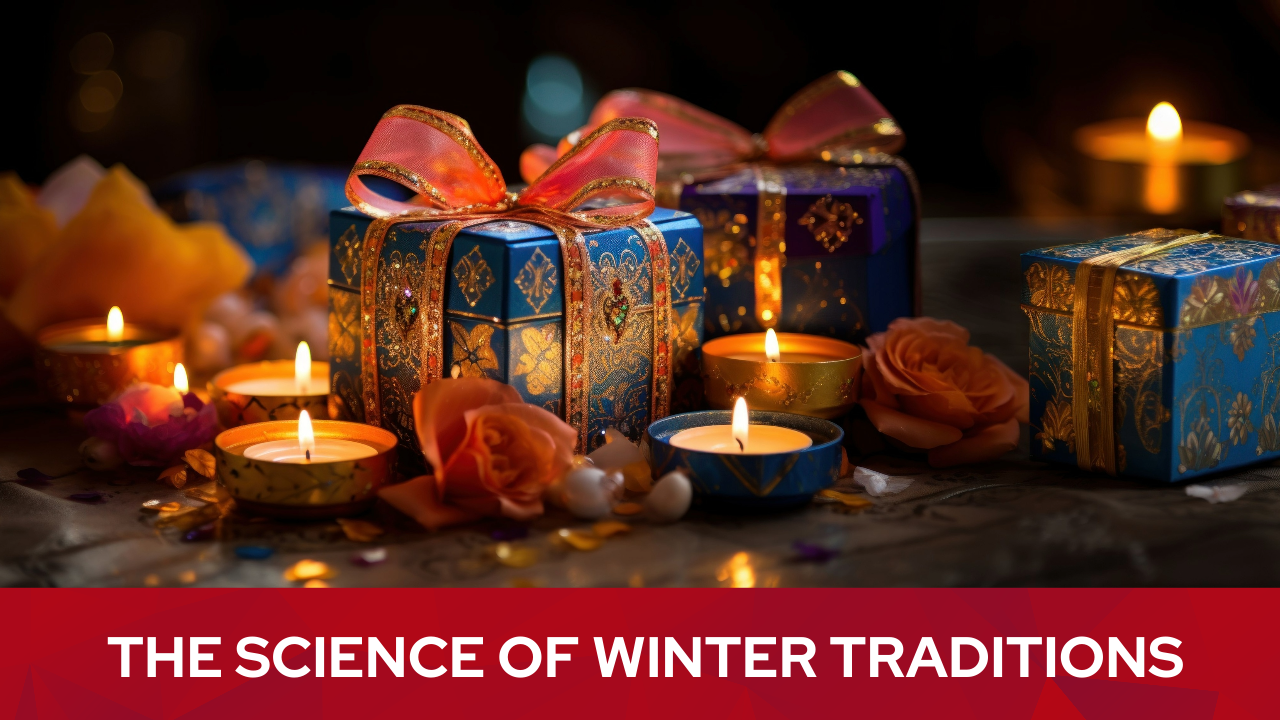The Phenomenon of Seasonal Joy
Winter brings a rich and varied tapestry of traditions that highlight the beauty of cultural differences. As we adorn our homes with festive lights and celebrate the season with loved ones, we are also reminded that woven through this tapestry of winter traditions is also the thread of our common humanity. In this article, we explore the commonality within our customs through the lens of science, and scientific foundations. From the astronomical rhythms of the winter solstice to the alchemy of warming spices, the science behind winter traditions is as fascinating as the traditions themselves.

The Biological and Astronomical Basis of Winter Traditions
At the heart of winter traditions lies the Winter Solstice, the shortest day and longest night of the year. Scientifically, this phenomenon occurs due to the axial tilt of the Earth as it orbits the sun. In a PBS News Hour article, William Teets, an astronomer at Vanderbilt University, adds, “Believe it or not, we [the Earth] is closest to the sun in January,” a reminder that the Earth’s tilt is responsible for the changing seasons, not the Earth’s distance from the sun. On the 21st of December, the winter solstice in the Northern Hemisphere marks a pivotal point where daylight hours reach their minimum. At the same time, the Southern Hemisphere is celebrating the summer solstice, marking the longest day of the year. The celestial event has long been associated with celebrations, symbolizing the triumph of light over darkness.
On a biological level, winter’s shorter days and reduced sunlight can influence our internal clock or circadian rhythm. The decrease in natural light exposure can lead to an uptick in melatonin production, the hormone responsible for regulating sleep. This shift in our biological patterns is also linked to Seasonal Affective Disorder (SAD), a form of depression that typically occurs during the winter months. Understanding these biological rhythms adds a layer of appreciation for the significance of winter traditions, as a means of slowing down, finding rest, and combating the seasonal blues.
The Psychology and Chemistry of Hot Beverages
Winter cuisine is a testament to the chemistry of comfort and celebration. Many cultures drink hot, spiced beverages such as wassail, sujeonggwa, and champurrado, especially during winter, for a calming effect on the mind and body. On a strictly biological level, when humans experience a sudden change in bodily temperature from holding a warm beverage, cortisol is released in the body, which is a chemical that helps regulate stress. According to John Hopkins Medicine, the regular consumption of certain spices was also linked to decreased rates of depression and mitigating the pain caused by arthritis. As discussed, colder weather, decreased daylight, and very busy holiday schedules can further intensify a person’s genetic or environmental influence to have depression or arthritis.
There is also a psychological and cultural dimension to consuming warm beverages which humans may employ to find a more joyful connection with others and their environment. According to several studies outlined in the Guardian, holding and consuming hot drinks has a psychological effect on human perception and behavior. One study conducted in the United Kingdom indicated that strangers holding hot drinks, such as a cup of coffee, were more likely to be perceived as trustworthy and to exhibit generous behavior. In other words, the interaction between heat and ingredients like cinnamon, cloves, and citrus creates a sensory experience that goes beyond taste. There are social, psychological, and biological benefits to our sensory connection to warm, spiced beverages, or food, for that matter.
The Neuroscience of Holiday Gifts
Gift-giving is a practice all cultures share; and, our practices of giving and receiving during winter certainly are varied and diverse. A variety of winter traditions globally exemplify the significance of gift-giving in fostering social bonds and spreading joy. Diwali, Hanukkah, Christmas, Kwanzaa, New Year celebrations, and Lunar New Year festivities all involve the exchange of gifts, symbolizing unity and goodwill within communities. Gift-giving isn’t just a nice gesture for humans; it’s a neuroscientific marvel. When we engage in the act of giving and receiving gifts, our brains release neurotransmitters such as dopamine and oxytocin. These chemicals play a crucial role in shaping our emotional experiences.
Dopamine, often referred to as the “reward neurotransmitter,” contributes to feelings of pleasure and reinforcement. Oxytocin, known as the “love hormone,” enhances social connections and fosters a sense of trust and closeness. The importance of this neurological response lies in its ability to promote positive emotions and strengthen social bonds. When these neurotransmitters are not released or are imbalanced, it can lead to a range of emotional and social challenges. Lack of dopamine is associated with feelings of apathy and reduced motivation, while a deficiency in oxytocin may contribute to difficulties in forming and maintaining social relationships. The neurochemistry of gift-giving unveils its profound impact on human well-being, providing insights into the role of neurotransmitters in shaping our emotional landscapes and strengthening social connections.
Conclusion
Winter traditions are more than festive rituals; they are a celebration of the natural world, a dance between the scientific wonders of our planet and the cultural expressions of humanity. By delving into the science behind these traditions, we gain a deeper appreciation of winter a season of wonder and joy. From the celestial beauty of the winter solstice to the intricate dance of neurotransmitters in response to gift-giving, each tradition provides insights into the intricate interplay between environment, biology, and culture. As we move through the winter season, these traditions are expressions not only of our cultural identity, but of the brilliance of our humanity: the ingenious ways we humans adapt our senses, elevate our mood, and foster the emotional connections essential for human well-being.

